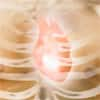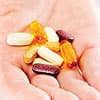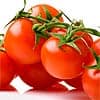
What's hot
What's hot
| News flashes are posted here frequently to keep you up-to-date with the latest advances in health and longevity. We have an unparalleled track record of breaking stories about life extension advances.
How broccoli helps beat cancer
Fung-Lung Chung and colleagues had previously discovered that isothiocyanates halt cancer growth by inducing apoptosis. In the current experiments, the effects of phenethylisothiocyanate (which is abundant in watercress), and other natural and synthetic ITCs were evaluated in cultured cancer and noncancerous cells with mutant or normal p53. The scientists observed that isothiocyanates removed defective p53 without affecting nonmutated, or “wild-type” p53. “In this study, we demonstrate that, depending on the structure, ITCs can robustly deplete mutant p53 protein in a variety of cancer cells in a time- and dose-dependent manner,” the authors write. “The depletion appears to be specific to mutant p53, because wild-type p53 is not affected by the same treatments.” “This is the first report of mutant p53 as a potential novel target for ITCs,” they announce. “Depletion of mutant p53 may reduce drug resistance and lead to new strategies for treating cancer in the clinic.” “Additional in vivo studies are warranted to fully understand the underlying mechanisms of mutant p53 depletion by ITCs and its functional consequences,” they conclude. —D Dye
Study fails to find adverse impact of folate fortification on colorectal cancer risk
Researchers from Harvard and Sookmyung Women’s University in Korea analyzed data from participants in the Health Professionals Follow-Up Study and the Nurses’ Health Study who completed dietary questionnaires upon enrollment. Over the follow-up periods, 5655 cases of colorectal polyps and 2299 cases of colorectal cancer occurred. Men and women whose total folate intake averaged 800 micrograms per day or higher had a 31 percent lower risk of colorectal cancer compared to those whose intake averaged less than 250 micrograms during the 12 to 16 years preceding diagnosis. A benefit for higher folate intake during the recent past was not observed. For colorectal adenomas, both long and short-term intake was associated with a reduction in risk. No adverse effects of either total folate or synthetic folic acid were observed on the risk of colorectal adenoma or cancer. “Because the adenoma-carcinoma sequence is the process underlying the development of most colorectal cancer, our findings suggested that higher folate intake may reduce early development of colorectal carcinogenesis,” the authors write. “We did not find any clear evidence that intake of folate, including folic acid added to foods or used as supplements, increased risk of colorectal cancer. Instead, our study supported the hypothesis that folate intake decreases risk of initiation or early development of colorectal cancer.” —D Dye
Depression linked to quality of fat consumed
For the current study, University of Las Palmas de Gran Canaria Associate Professor of Preventive Medicine Almudena Sánchez-Villegas and associates followed 12,059 Spanish University graduates enrolled in the Seguimiento Universidad de Navarra project. Questionnaires completed upon enrollment were analyzed for the intake of saturated fatty acids, polyunsaturated fatty acids, trans fatty acids, monounsaturated fatty acids, and culinary fats including olive oil and margarine. Over a median of 6.1 years, 657 cases of depression occurred. Subjects whose intake of trans-fats was high "presented up to a 48% increase in the risk of depression when they were compared to participants who did not consume these fats, whereby the more trans-fats were consumed, the greater the harmful effect they produced in the volunteers," reported Dr Sánchez-Villegas. When polyunsaturated fats were analyzed, an opposite effect was revealed. "In fact, we discovered that this type of healthier fats, together with olive oil, are associated with a lower risk of suffering depression," stated research team leader Miguel Ángel Martínez-González, who is a Professor of Preventive Medicine at the University of Navarra. The authors note that cardiovascular disease and depression appear to share common mechanisms, and may be influenced similarly by diet. “To our knowledge, the association between trans fatty acids and depression risk had not been reported before,” they announce. “Our results support a relationship between fat subtypes and depression which may parallel the well known effects of the quality of lipid intake on cardiovascular disease risk.” —D Dye
Nutritional biomarkers will aid in Alzheimer’s studies
Oregon State University professor of nutrition Emily Ho and her associates analyzed 26 plasma nutrient biomarkers measured at baseline and after one month in 38 older individuals, and evaluated the subjects’ responses to dietary questionnaires concerning the intake of these nutrients. They found that dietary questionnaire responses correlated with specific nutrient levels only in participants without cognitive impairment. “One of the issues in doing a good study is understanding the nutritional status of your participants when you start and how the nutrient treatment changes it,” Dr Ho remarked. “Giving supplements or foods to a person who already has a normal nutritional status of that nutrient may be very different than if the person is deficient.” “Dietary and nutritional studies have yielded some intriguing results, but they are inconsistent,” she stated. “If we are going to determine with scientific accuracy whether one or another nutritional approach to preventing dementia may have value, we must have methods that accurately reflect the nutritional status of patients. The gold standard to assess nutritional status should be biomarkers based on blood tests.” —D Dye
Diets providing more fruit and vegetables associated with fewer heart disease deaths
Dr Francesca Crowe of the Cancer Epidemiology Unit at the University of Oxford and her colleagues analyzed data from 313,074 participants in the European Prospective Investigation into Cancer and Nutrition (EPIC) Heart study, which included men and women aged 40 to 85. Subjects provided information concerning diet and other factors upon enrollment beginning in 1992. “This study involved over 300,000 people in eight different European countries, with 1,636 deaths from IHD,” Dr Crowe stated. “It shows a 4% reduced risk of dying from IHD for each additional portion of fruit and vegetables consumed above the lowest intake of two portions. In other words, the risk of a fatal IHD for someone eating five portions of fruit and vegetables a day would be 4% lower compared to someone consuming four portions a day, and so on up to eight portions or more." "The main message from this analysis is that, in this study, people who consume more fruits and vegetables have lower risk of dying from IHD,” she added. “However, we need to be cautious in our interpretation of the results because we are unsure whether the association between fruit and vegetable intake and risk of IHD is due to some other component of diet or lifestyle. If we could understand, by means of well-designed intervention studies, the biological mechanisms that could underlie the association between fruits and vegetables and IHD, this might help to determine whether or not the relation between fruit and vegetables with IHD risk is causal." —D Dye
Antioxidant supplementation by men improves a couple’s conception chances
Marian G. Showell of the University of Auckland in New Zealand, in collaboration with researchers from Australia, reviewed 34 randomized, controlled trials that included a total of 2,876 couples undergoing assisted reproductive techniques such as in vitro fertilization. The majority of the men had reduced sperm counts and motility. Trials evaluated the use by the male partner of one or more antioxidants (including vitamin E, zinc, L-carnitine, and others) and assessed their effects on such end points as live birth, pregnancy and sperm motility. Antioxidant use was associated with a greater likelihood of pregnancy and live birth compared to a placebo or no treatment. Improvements in sperm motility and concentration were also observed in association with antioxidant use in trials that evaluated these effects. No harmful effects associated with antioxidant treatment were noted. The authors remark that 30 to 80 percent of the cases of subfertility in men may be due to damaged sperm resulting from oxidative stress. "When trying to conceive as part of an assisted reproductive program, it may be advisable to encourage men to take oral antioxidant supplements to improve their partners' chances of becoming pregnant," stated Dr Showell, of the University of Auckland’s department of Obstetrics and Gynecology. "However, these conclusions are currently based on limited evidence." "We need more head-to-comparisons to understand whether any one antioxidant is performing better than any other," Dr Showell added. —D Dye
Berries benefit blood pressure
The current study included 23,043 men who participated in the Health Professionals Follow-up Study and 133,914 women enrolled in the Nurses’ Health Study. Dietary intake was assessed every four years over a 14 year average follow-up period. Over the course of follow-up, 34,647 subjects were diagnosed with high blood pressure. The research team uncovered a lower risk of hypertension in men and women whose anthocyanins intake was highest. Those whose intake of the compounds was greatest experienced an 8 percent lower risk of being diagnosed with hypertension than those whose intake was least, and for subjects under the age of 60, the risk was 12 percent lower. Strawberries and blueberries were the most common sources of anthocyanins consumed by the populations included in this study. Consuming one or more servings of blueberries per week was associated with a 10 percent lower risk of developing hypertension compared to the risk experienced by those who failed to include the fruit in their diet. “Anthocyanins are readily incorporated into the diet as they are present in many commonly consumed foods,” noted Dr Cassidy, who is affiliated with the University of East Anglia Medical School’s Department of Nutrition. “Blueberries were the richest source in this particular study as they are frequently consumed in the US. Other rich sources of anthocyanins in the UK include blackcurrants, blood oranges, aubergines and raspberries.” “Our findings are exciting and suggest that an achievable dietary intake of anthocyanins may contribute to the prevention of hypertension,” he concluded. —D Dye
Longevity-associated protein protects the prostate
Kimmel Cancer Center director Richard G. Pestell, MD, PhD, along with researchers at the Herbert Irving Comprehensive Cancer Center at Columbia University and the Ottawa Health Research Institute at the University of Ottawa, conducted a study involving mice that possessed an intact gene for the enzyme and mice in which the gene was deleted. Deletion of the gene was shown to result in cellular hyperplasia and other features of prostate intraepithelial neoplasia. Further research determined that loss of Sirt1 inhibits autophagy, a degradation of the cell’s components which regulates normal gland development. "If you inactivate this gene, then you get the prostate cancer precursor, known as PIN,” explained Dr Pestell, who is the Chairman of Cancer Biology at Thomas Jefferson University. “So it tells you that this 'longevity' gene is normally blocking prostate cancer." The researchers hope that the finding could contribute to the development of drugs that help prevent prostate cancer as well as aging. "Prostate cancer is one of the malignancies that has a very direct relationship to aging," he noted. "And these results provide a direct link for the first time between the onset of prostate cancer and the Sirt1 gene that regulates aging." —D Dye
Resveratrol stimulates antiobesity hormone
Professor of pharmacology Feng Liu, PhD of the University of Texas Health Science Center Barshop Institute of Longevity and Aging Studies in San Antonio and his colleagues studied the effects of resveratrol in cultured fat cells. They found that the compound stimulated the expression of adiponectin, a hormone derived from cells that manufacture and store fat, which has been shown to have benefits in complications related to obesity. Resveratrol as well as adiponectin have been found in previous research to act against obesity, insulin resistance and aging. The current findings were confirmed in mice given a resveratrol-supplemented diet. “Because enhancing adiponectin levels increases resistance to inflammation, insulin resistance, and cardiovascular disorders, the finding that resveratrol promotes adiponectin expression levels thus provides a novel mechanism by which resveratrol exerts its health beneficial functions,” the authors conclude. In other research conducted at the Barshop Institute, described in a letter published in the July 16, 2009 issue of the journal Nature, David E. Harrison and his associates uncovered a life-extending benefit for the drug rapamycin. The following year, Dr Liu and his associates reported that resveratrol inhibits the activity of the mammalian target of this drug (mTOR). “Results from these studies should be of interest to those who are obese, diabetic and growing older,” stated Dr Liu. “The findings should also provide important information on the development of novel therapeutic drugs for the treatment of these diseases.” —D Dye
Beneficial tomato compound identified
Dr Teruo Kawada of Kyoto University and colleagues screened fractions of tomato extracts and identified 9-oxo-octadecadienoic acid (9-oxo-ODA) as increasing peroxisome proliferator-activated receptor alpha (PPARa) reporter activity in mouse liver cells. PPARa is a commonly accepted target for correcting lipid metabolism abnormalities. 9-oxo-ODA increased the expression of PPAR-alpha genes involved in fatty acid oxidation and inhibited triglyceride accumulation in the cells. “These findings suggest that 9-oxo-ODA enhances fatty acid oxidation in hepatocytes through PPARa activation,” the authors concluded. "Dyslipidemia itself usually causes no symptoms, however; it can lead to symptomatic vascular diseases, such as arteriosclerosis and cirrhosis,” Dr Kawada remarked. “In order to prevent these diseases it is important to prevent an increased build up of lipids." "Finding a compound which helps the prevention of obesity-related chronic diseases in foodstuffs is a great advantage to tackling these diseases", he added. "It means that the tomato allows people to easily manage the onset of dyslipidemia through their daily diet." —D Dye
Vitamin D boosts TB treatment in specific group of patients
Dr Adrian Martineau of the Centre for Health Sciences at Barts and The London School of Medicine and Dentistry and colleagues randomized 146 men and women with drug-sensitive tuberculosis to receive 2.5 mg vitamin D3 or a placebo 14, 28, and 42 days after beginning antimicrobial treatment. Sputum samples were collected and cultured at these time points in addition to the beginning and end of the 56-week study. Ninety-seven percent of the subjects had inadequate vitamin D levels at the start of the trial. Sputum cultures tested negative for the TB bacteria after an average of 5 weeks for those who received vitamin D compared to 6 weeks for the placebo group, a difference that was not considered significant. However, for those with a particular genetically determined type of vitamin D receptor, the response to therapy was significantly more rapid. "Vitamin D is best known for its effects on bones - it prevents rickets and osteomalacia - but it also has important effects on the immune system,” Dr Martineau observed. “High dose vitamin D was used to treat TB in the days before antibiotics were available, but clinical trials have not previously been performed to find out how TB patients' genetic make-up can affect their response to vitamin D supplementation. The finding that patients who have a particular type of vitamin D receptor are very responsive to vitamin D is new and gives us insights into how vitamin D can affect the immune response." —D Dye
Reduced vitamin C and E levels associated with metabolic syndrome
The study included 127 men and 225 women whose age averaged 74.4 years. Physical examinations collected anthropometric data and blood samples were analyzed for vitamins A, B6, B12, C, D and E; folate, calcium, copper, iron, zinc, homocysteine, glucose, lipids and C-reactive protein, a marker of inflammation. Dietary questionnaire responses were evaluated for the intake of various nutrients and correlated with plasma levels. Nineteen percent of the men and 81 percent of the women were determined to have metabolic syndrome, which was associated with high serum C-reactive protein levels. Having a low plasma vitamin C level was associated with a significantly increased risk of metabolic syndrome compared to those whose levels were not low. Vitamin E was also found to be protective against metabolic syndrome, although the effect was less pronounced than that associated with vitamin C. “In this population of low-income Ecuadorians, we observed a pattern of high carbohydrate, high sodium diets lacking in healthy fats and good sources of protein,” stated senior author Simin Nikbin Meydani, PhD, DVM, who is the director of the Jean Mayer USDA Human Nutrition Research Center on Aging at Tufts University. “Our blood analyses indicate a significant number of participants weren’t consuming enough of a range of micronutrients.” “With high-calorie foods lacking essential nutrients serving as pillars of the diet, it is possible to be both overweight and malnourished,” she noted. —D Dye
Supplement use associated with greater survival, less recurrence in breast cancer patients
The study included 4,877 Chinese women with invasive breast cancer enrolled in the Shanghai Breast Cancer Survival Study. Participants were limited to those who underwent surgery for their tumors and for whom the current diagnosis of breast cancer was their first. Interviews conducted an average of 6.5 months after diagnosis provided information on the use of vitamin supplements during treatment. During a 4.1 year average follow-up period, 532 participants had a recurrence of their disease, 389 participants died from breast cancer and 55 from other causes. Use of any vitamins was associated with a lower risk of breast cancer recurrence or death over follow-up. Those who used vitamin C for more than 3 months had a 38 percent lower risk of recurrence and a 44 percent lower risk of dying than those who did not report using the vitamin, and for vitamin E use over 3 months, the risk of recurrence and death were 48 and 43 percent lower. “There is a widespread concern that the use of antioxidant supplements during cancer treatment may protect tumor cells from the oxidative damage induced by cancer therapies, thereby reducing the effectiveness of treatment and increasing risk of mortality,” the authors write. “We found no evidence that vitamin use during the first six months following diagnosis had a detrimental effect on breast cancer outcomes.” —D Dye |

 While cruciferous vegetables, including broccoli, watercress and Brussels sprouts, are known to help protect against
While cruciferous vegetables, including broccoli, watercress and Brussels sprouts, are known to help protect against  An article published online on January 26, 2011 in the
An article published online on January 26, 2011 in the  An article published online on January 27, 2011 in
An article published online on January 27, 2011 in  Research conducted by the Linus Pauling Institute at Oregon State University, described online on November 3, 2010 in the journal
Research conducted by the Linus Pauling Institute at Oregon State University, described online on November 3, 2010 in the journal  An article published online on January 19, 2010 in the
An article published online on January 19, 2010 in the  A review published in
A review published in  In a report scheduled for publication in the February, 2011 issue of the
In a report scheduled for publication in the February, 2011 issue of the  In the February 1 issue of the journal
In the February 1 issue of the journal  An article published in the January 7, 2011 issue of the
An article published in the January 7, 2011 issue of the  An article published recently in the journal
An article published recently in the journal  The results of a clinical trial published on January 6, 2011 in
The results of a clinical trial published on January 6, 2011 in  Research described recently in the journal
Research described recently in the journal  On December 21, 2010, the journal
On December 21, 2010, the journal